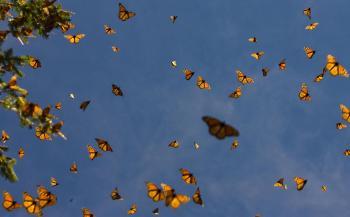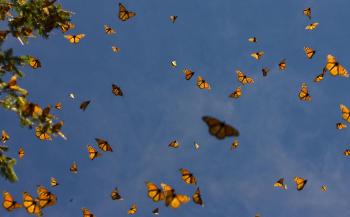Every autumn, thousands of monarch butterflies gather at Point Pelee National Park in Ontario before embarking on one of nature’s most astounding journeys—an over 1,800 mile trip to central Mexico.
The tip of the Pelee peninsula, Canada’s southern-most landmass, acts as a jumping-off point for the butterflies, providing a shorter way across Lake Erie as they head south.
“They come from further north, and Point Pelee is a stopping ground on their way,” says Meaghan Ruston, Point Pelee National Park’s promotions officer.
Although monarchs have been undertaking this monumental journey for thousands of years, it was only in the mid-1970s that researchers discovered they were overwintering in the volcanic mountain ranges of central Mexico.
That such a small insect can travel so far is considered a scientific wonder. Even more remarkable is that the monarchs that migrate to Mexico for their winter hibernation have never been there before.
But the survival of this marvel of nature is in jeopardy, so much so that Canada, the United States, and Mexico agreed in 2007 to work together to protect the monarch’s habitat.
As a result, the North American Monarch Conservation Plan (NAMCP) was drawn up and implemented to address some of the threats to the monarchs—threats that include pesticides, climate change, and illegal logging in Mexico’s oyamel fir forest, a unique mountain habitat where they spend the winter.
Karen Oberhauser, NAMCP principle author and an associate professor at the University of Minnesota, says that because monarchs in Canada and the United States depend upon a vast range of habitats that lie outside national parks or government land, “education is really important.”
“A lot of it is outreach—trying to encourage people to either preserve habitat or create habitat for monarchs,” she says.
This includes encouraging farmers to grow plants on the edges of their fields that support monarch populations and have city dwellers plant monarch-friendly gardens or natural areas in their yards.
Herbicides that kill milkweed—the only plant that monarch caterpillars eat, are also a problem for the butterflies.
The all-important milkweed, Oberhauser said, is “one of the big conservation efforts that we’re working on right now.”
The tip of the Pelee peninsula, Canada’s southern-most landmass, acts as a jumping-off point for the butterflies, providing a shorter way across Lake Erie as they head south.
“They come from further north, and Point Pelee is a stopping ground on their way,” says Meaghan Ruston, Point Pelee National Park’s promotions officer.
Although monarchs have been undertaking this monumental journey for thousands of years, it was only in the mid-1970s that researchers discovered they were overwintering in the volcanic mountain ranges of central Mexico.
That such a small insect can travel so far is considered a scientific wonder. Even more remarkable is that the monarchs that migrate to Mexico for their winter hibernation have never been there before.
But the survival of this marvel of nature is in jeopardy, so much so that Canada, the United States, and Mexico agreed in 2007 to work together to protect the monarch’s habitat.
As a result, the North American Monarch Conservation Plan (NAMCP) was drawn up and implemented to address some of the threats to the monarchs—threats that include pesticides, climate change, and illegal logging in Mexico’s oyamel fir forest, a unique mountain habitat where they spend the winter.
Karen Oberhauser, NAMCP principle author and an associate professor at the University of Minnesota, says that because monarchs in Canada and the United States depend upon a vast range of habitats that lie outside national parks or government land, “education is really important.”
“A lot of it is outreach—trying to encourage people to either preserve habitat or create habitat for monarchs,” she says.
This includes encouraging farmers to grow plants on the edges of their fields that support monarch populations and have city dwellers plant monarch-friendly gardens or natural areas in their yards.
Herbicides that kill milkweed—the only plant that monarch caterpillars eat, are also a problem for the butterflies.
The all-important milkweed, Oberhauser said, is “one of the big conservation efforts that we’re working on right now.”







